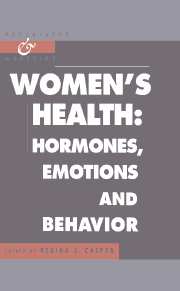Book contents
- Frontmatter
- Contents
- Preface
- 1 Growing up female
- 2 Reproduction and its psychopathology
- 3 Women's sexual function and dysfunction
- 4 Gender differences in brain morphology and in psychiatric disorders
- 5 Thyroid hormones in major depressive disorder and bipolar disorder
- 6 The hypothalamic-pituitary-adrenocortical system
- 7 The cost of starvation: Eating disorders
- 8 Coronary artery disease and women: Estrogens and psychosocial and lifestyle risk factors
- 9 The psychophysiology of breast cancer: Disease, hormones, immunity, and stress
- 10 The psychopharmacology of women
- 11 Intervention trials concerned with disease prevention in women
- References
- Index
6 - The hypothalamic-pituitary-adrenocortical system
Published online by Cambridge University Press: 08 February 2010
- Frontmatter
- Contents
- Preface
- 1 Growing up female
- 2 Reproduction and its psychopathology
- 3 Women's sexual function and dysfunction
- 4 Gender differences in brain morphology and in psychiatric disorders
- 5 Thyroid hormones in major depressive disorder and bipolar disorder
- 6 The hypothalamic-pituitary-adrenocortical system
- 7 The cost of starvation: Eating disorders
- 8 Coronary artery disease and women: Estrogens and psychosocial and lifestyle risk factors
- 9 The psychophysiology of breast cancer: Disease, hormones, immunity, and stress
- 10 The psychopharmacology of women
- 11 Intervention trials concerned with disease prevention in women
- References
- Index
Summary
Introduction
The hypothalamic-pituitary-adrenal (HPA) axis has undoubtedly received more psychobiologic scrutiny than any other endocrine axis. Historically, one rationale for the intensive study of adrenocortical function in patients with primary psychiatric disorders was the observation that patients with primary endocrine disorders such as Addison's disease (Fava, Sonino, and Murphy, 1987; Lobo et al., 1988) or Cushing's syndrome (Loosen, Chambliss, DeBold, Shelton, Orth et al., 1992;Kling et al., 1993) exhibited a higher than expected psychiatric morbidity. This led to the so-called neuroendocrine window strategy based on a large literature which indicates that the secretion of the target endocrine organs, for example, the adrenal or thyroid, is largely controlled by their respective pituitary trophic hormones. The pituitary tropic hormones, in turn, are controlled primarily by the secretion of their respective hypothalamic release and/or release-inhibiting hormones. There is now considerable evidence that the secretion of these hypothalamic hypophysiotropic hormones is controlled by serotonin, acetylcholine, and norepinephrine, neurotransmitters previously posited to play a preeminent role in the pathophysiology of affective and/or anxiety disorders. This neuroendocrine window strategy remains an impetus for continuing investigation of the major endocrine axes in psychiatric disorders. However, the hypothesis that information about higher central nervous system (CNS) neuronal activity, such as the activity of serotonergic neurons in a particular disease state, may be inferred solely by measuring the activity of a specific endocrine axis is far from proven and is fraught with problems. It is unclear if alterations in peripheral adrenal hormone secretion or altered secretion of pituitary and hypothalamic hormones primarily contribute to the pathogenesis of depression. What the neuroendocrine window strategy has provided, however, is clear evidence for alterations in the activity of the HPA axis in depression and an appreciation of the complexity of the regulation of its activity in women and in men.
Keywords
- Type
- Chapter
- Information
- Women's HealthHormones, Emotions and Behavior, pp. 109 - 121Publisher: Cambridge University PressPrint publication year: 1997

